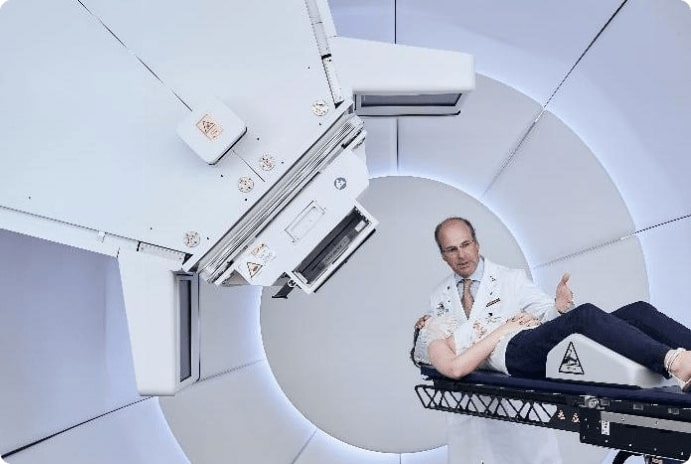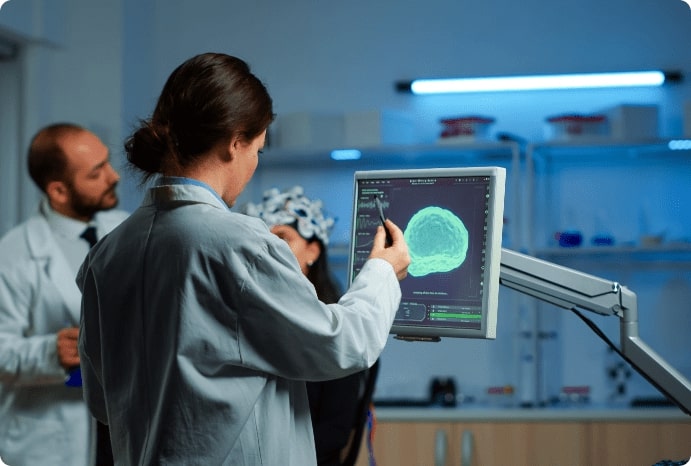
Powered by Thyrocare, Nueclear Healthcare Limited was founded in 2011. We focus on cancer diagnosis by testing, analysing, establishing and setting up diagnostic centres in the field of nuclear scanning and radiology imaging techniques. We offer a range of comprehensive solutions and assessments for accurate diagnosis of a broad spectrum of ailments.
Till date, we have processed 200,000+ PET-CT scans across India. We have a vast network of over 20K+ doctors and 3K+ oncologists who trust and recommend Nueclear. Our imaging centres are led by physicians skilled in nuclear medicine to provide excellent patient care.

Nuclear Medicine is a clinical specialty where radiopharmaceuticals are administered to the patients for various diagnostic and therapeutic applications. Radiopharmaceuticals are radioactive drugs that consist of two components, radioactive and non-radioactive. The non-radioactive component determines the mode and organ of localization (specificity of localization in the organ of interest) and the kinetics of its biodistribution. The radioactive isotope is tagged to the non-radioactive component and the radiations emitted are used to image its invivo distribution.
Nuclear Medicine is broadly classified into “Diagnostic Nuclear Medicine” and “Therapeutic Nuclear Medicine”.
Diagnostic Nuclear Medicine involves the administration of trace quantities of radiopharmaceuticals to diagnose functional abnormalities in body tissues. It involves invivo imaging, invivo non-imaging (e.g. thyroid uptake studies, gfr estimation by plasma sampling) and in-vitro laboratory procedures (e.g. Radioimmunoassays).
The invivo imaging is broadly divided into Planar Imaging, Single Photon Emission Computed Tomography (SPECT) and Positron Emission Tomography (PET).
The most commonly used radioisotope for Planar and SPECT imaging is Technetium-99m (99mTc), having a physical half-life of 6 hours. The 99Mo-99mTc radionuclide generators are the typical routine in-house laboratory source of 99mTc availability in a nuclear medicine department. These generators have a useful life of around 7-15 days and need to be periodically replaced.
The most commonly used radioisotope for PET imaging is Fluorine-18 (18F). The 18F labelled radiopharmaceuticals are produced in a Medical Cyclotron facility and are supplied to PET centres. The short half-life of 110 minutes often does not permit its transportation to distant PET facilities.
The radiopharmaceuticals in nuclear medicine are available in a variety of forms viz. solution, colloidal solution, capsules or aerosols. Depending on its form, they are either administered intravenously, intracavitary, orally or through inhalation.
The gamma radiations emitted by the radiopharmaceuticals are detected by specialised detectors (scintillation detectors) which convert the incident radiation into light energy. This light energy is converted into electric signals and is processed further using sophisticated reconstruction algorithms to generate an image of the biodistribution of radiopharmaceutical.
Therapeutic nuclear medicine involves the administration of radiopharmaceuticals for curative (e.g. 131I-Sodium Iodide for treatment of hyperfunctioning thyroid gland in Graves’ disease, differentiated thyroid cancer) or palliative (e.g. 153mSm-EDTMP for bone pain palliation) applications.
Nuclear Medicine differs from Radiology in the following ways:
Molecular imaging is a discipline that enables the visualisation, characterization, and quantitation of biological processes taking place at the cellular level in living organisms without perturbing them. The Nuclear Medicine procedures like SPECT and PET imaging, functional MRI and optical imaging are examples of molecular imaging.
PET scan is a functional diagnostic imaging modality that involves the administration of a positron radiation-emitting radiopharmaceutical to map the various invivo biological processes. It provides clinicians with 3-dimensional images and information about how organs/tissues inside the body are functioning at the cellular and molecular levels.
When a CT scan is performed along with a PET scan, as a part of the same diagnostic workup, it is termed PET-CT fusion imaging. It uniquely combines the functional information provided by the PET scan with the anatomical information obtained from the CT scan. Fusion imaging with a CT scan thus helps localise the functional abnormality and characterise the lesion. This increases the sensitivity, specificity and overall diagnostic accuracy when compared to PET and CT alone.
PET-CT has emerged as an important complementary modality that is advancing our understanding of the underlying cause of disease and improving disease detection and management.
It provides information that may not be possible to obtain from other imaging techniques or possibly would require the use of more invasive procedures such as biopsy or surgery.
PET-CT fusion imaging helps
‘Positron radiation emitting’ radioisotope-based radiopharmaceuticals are used for PET imaging. Positrons per se are not useful for imaging as they will be absorbed within the body. However, a positron travels a short distance before losing its kinetic energy. It then annihilates with an electron to emit 2 photons of 511 keV each, which travel in opposite directions. These annihilation photons (and not positrons) are detected by the PET scanner and the light signals generated are processed by computers to provide 3-dimensional images of the tracer distribution in the body.
The most widely available PET tracers in India are 18F-Fluorodeoxyglucose (18F-FDG) & 18F-Sodium Fluoride (18F-NaF).
18F-FDG: Almost 90% of PET-CT studies are performed using 18F-FDG. Also called as the “Molecule of the Century,” 18F-FDG is a glucose analog in which the hydroxyl group at C-2 position is substituted by 18F. It is taken up by the cells via Glucose Transporter (GLUT) receptors and is subsequently phosphorylated by the Hexokinase enzyme to Fluorodeoxyglucose-6-phosphate. However, it cannot be further metabolised to deoxy fructose-6-phosphate as this step involves rearranging the carbonyl group from C-1 to C-2 position in the ring and thus getting trapped in the cells. This “metabolic trapping” of 18F-FDG forms the basis of the 18F-FDG PET-CT scan.
18F-NaF: It is used for imaging the skeletal system. It is localised in bones by binding to the hydroxyl group of the Hydroxyapatite. It has higher sensitivity and diagnostic accuracy than the conventionally used 99mTc-MDP Bone scan.
Yes! A PET Scan is an O.P.D. procedure.
18F-FDG PET-CT scan has proven efficacy in various oncological and non-oncological applications. They are summarised below:
(a) Oncological Applications
There are subtle biochemical differences between normal cells and malignant cells. In malignant cells, there is upregulation of GLUT receptors, overexpression of Hexokinase, and absence or very low levels of Glucose-6-Phosphatase. All these factors result in increased FDG uptake by tumour cells relative to the normal healthy cells. This increased FDG accumulation by malignant cells forms the basis of 18F-FDG PET-CT scan for oncological applications.
Some of the malignancies in which PET-CT modality is useful are described below:
Recently, 18F-NaF PET-CT scan has gained popularity as an alternative to the conventionally used 99mTc-MDP Bone scans due to the following advantages:
Yes! The PET-CT procedures are safe, painless, non-invasive, and cost-effective.
PET-CT scan procedures are rarely associated with any significant discomfort or side effects.
done in tandem. For a PET scan, the radiopharmaceutical is injected in small (tracer) quantities. It is excreted from the body through urine. The un-excreted radiopharmaceutical decays with a short half-life (110 minutes). Thus, the amount of radiation exposure received by the patient is very low.
| Sr No | Procedure | Effective Dose (mSv) |
|---|---|---|
| 1 | 18F FDG PET scan | 7 |
| 2 | 99mTc Bone Scan | 4.4 |
| 3 | Whole-body CT scan | 8-30 |
| 4 | CT head | 2 |
| 5 | CT chest | 8 |
| 6 | CT abdomen | 10 |
| 7 | CT pelvis | 10 |
| 8 | Coronary Angiography | 5-15 |
| 9 | Mammography | 0.13 |
| 10 | X-Ray chest | 0.04 |
| 11 | X-Ray Abdomen | 0.7 |
Source: http://hps.org/hpspublications/articles/dosesfrommedicalradiation.html
The estimated effective dose from a typical PET scan is 8 milliSievert (mSv). It is equivalent to the radiation dose received from the natural environment in 3 years. The effective dose from CT has a very wide range (8-30 mSv) depending on the type of the test, the region of the body scanned, and the purpose of the test.
The radiopharmaceuticals used for PET scans are absolutely safe and have no reported allergic reactions.
The CT scan done as a part of the PET-CT procedure may be performed with or without contrast enhancement. These contrast agents are known to cause allergic reactions in few patients as seen with any other contrast-enhanced CT procedure. The routinely used non-ionic contrast media are safe. However, in very few cases some side effects may be noticed as follows:
Minor Reactions: Itching, rashes, chills, nausea and vomiting. They are self-limiting and require no treatment.
Moderate reactions: They include dyspnea, tachycardia, generalised erythema and mild hypotension. The chance of such reactions is 1 in 1,000 i.e 0.1%.
Severe Reactions: They occur rarely and include convulsion, cardiopulmonary arrest, profound hypotension and arrhythmias. One in 1,00,000 studies (i.e. 0.01%) may lead to death.
Yes! However, it is recommended that the patient does not breastfeed her baby for 6-8 hours after the scan has been performed as small amounts of the administered radiopharmaceutical might be excreted in breast milk. It is advisable to collect expressed breast milk before the radiotracer injection so that it can be used to feed the baby.
Generally, there are no restrictions on patients’ social behaviour after a PET-CT scan. The patients may resume their routine activities immediately after the scan is over. However, it is advisable to avoid prolonged contact with infants, children and pregnant women for at least 6 hrs after the scan.
The PET-CT scan results are usually available within 2 days.
The accessibility of PET-CT scans has led to the widespread availability of metabolic scans which have reliable and better diagnostic results.
With the development of new specific radiotracers and targeted therapies, improvement in the resolution of imaging systems and fusion imaging with MRI, the existing list of applications of PET scan in clinical practice is likely to increase.